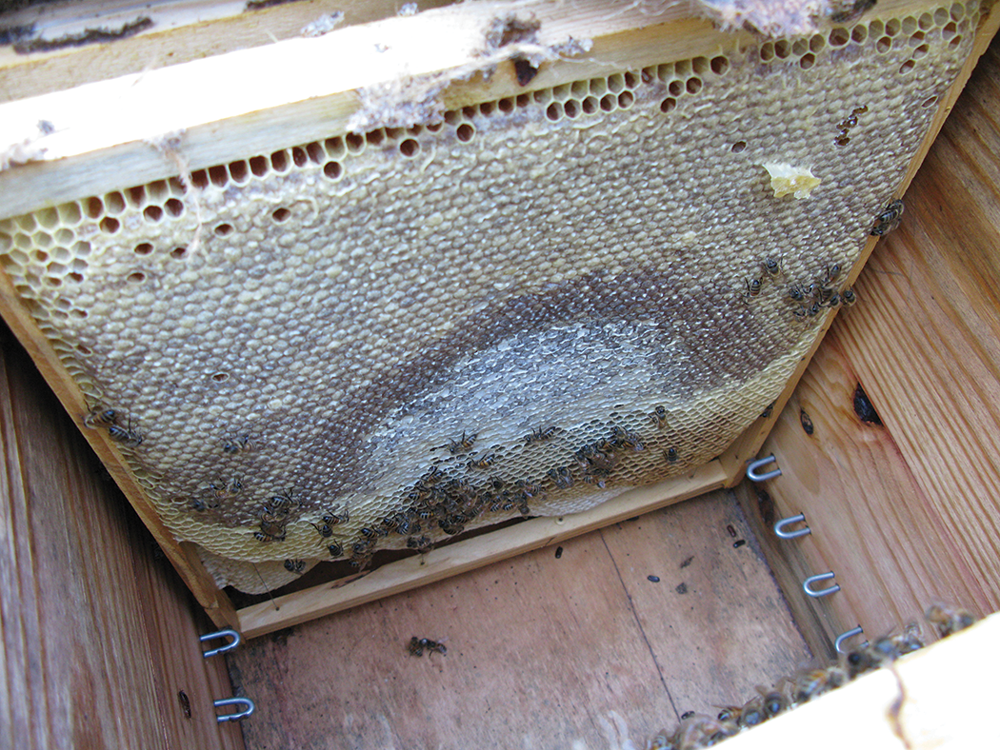Before going further, I should mention that my horizontal hives have two entrances, one on each end, and the brood nest is always at one end of the hive, instead of in the middle – either to the left or right, facing one of the two entrances, with the other entrance always kept shut. Since I believe that division boards are of no use, I haven’t used them in my hives for a long time now. But I have saved a few of them to use when transferring a colony or installing a swarm in a hive, in order to force the bees to build exclusively within the space I’ve given them.
In Spring, the brood frames should be surrounded by frames of drawn comb that are either empty or containing only a little honey (or none at all), so that the queen will not run out of room for laying eggs, right up until the period of the main honey flow. Meanwhile, the frames containing a lot of honey should be moved to the far end of the hive – the end furthest from the brood.1
I arrange all of my frames in this manner each Spring, giving the queen plenty of room to lay. Most of the old honey, if any remains in the hive by the time the main honey flow arrives, will be put through the extractor along with the new honey.
Between the first inspection and the honey harvest, all that’s necessary is an occasional stroll through the apiary to make sure the bees are working normally.
Robbing is no threat to remote outyards, as long as you’re keeping local bee races. The only case when you’ll need to keep an eye on your colonies is when you’re forced to feed them – and this should never happen, assuming you leave them enough honey in the Fall.
If, during one of these external inspections, you find a colony whose bees are exiting the hive with pollen on their legs, and bustling around the bottom board as if worried – and, at the same time, the bees seem to be working sluggishly or irregularly – then you can be almost certain that the colony has become queenless, or has a drone-laying queen. If this is the case, give the colony a frame of brood of all ages, or a queen, or a swarm.
Layens hive advantages – no heavy lifting, all frames the same size, large combs for strong Spring buildup and good overwintering.
In the Spring, it’s very important to check the brood’s condition carefully. If the brood is in tightly arranged patches, then the colony is in good shape: its queen is probably fertile, and its future is bright. This holds true regardless of how strong or weak the colony seems, or how much brood it contains.
If, however, you find that the brood is scattered, then the queen can’t be doing well. In most cases, the hive will replace its queen and eventually be in good shape for wintering and for the following season.
You may also discover that a colony is orphaned, or has a drone-laying queen. If this is the case – and it does happen from time to time (if not every year, in a large apiary) – then you can eliminate the now worthless colony using the simple method described below. But save this procedure for a nice day when the bees are highly active, which clearly indicates that there is nectar in the flowers.
Move the hive to the edge of the apiary, remove all of the frames, and brush the bees off onto a bottom board placed on the ground, in the sunlight. The bees will fly away, and, unable to find their old hive, will seek out the hospitality of the colonies surrounding their former home. The honey this orphaned hive contains can go toward the purchase of a replacement colony.
If you’re not able to carry out this procedure on the same day, you should greatly narrow the hive’s entrance for the time being to avoid robbing.
The best way to replace queenless hives is to set aside funds for honey sales for buying replacement colonies, since, by buying your colonies from other keepers, you’ll be constantly introducing fresh blood into your apiary. However, if you have multiple outyards at some distance from one another, you can also keep a small apiary of colonies in fixed-comb hives near your home, or moveable-frame hives with only a small number of frames inside – this apiary will be used to produce natural swarms for you to collect. This breeding apiary will allow you to fill in the gaps in your outyards as they arise.
The honey harvest
To obtain honey that is of high quality and has a long shelf life, you should only extract it from the combs when they are almost entirely capped. This means that I harvest late in the year, in September. Of course, this means that my sainfoin honey is mixed with honey from Fall flowers – but since, in order to find buyers easily, I have to sell my honey at roughly the same price set by local honey suppliers, and since the honey I produce using an extractor is infinitely superior to theirs, this blend of honey from various flowers presents no real problem. In any case, it’s convenient to harvest in the Fall, since by this time of year there are fewer bees in the colonies, which makes the entire process go more quickly.




